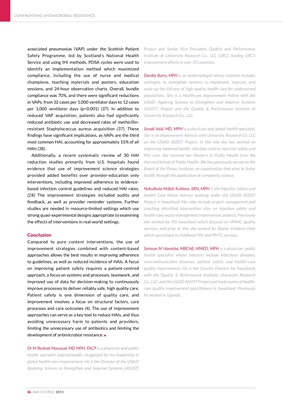
associated pneumonias (VAP) under the Scottish Patient
Safety Programme, led by Scotland's National Health
Service and using IHI methods. PDSA cycles were used to
identify an implementation method which maximized
compliance, including the use of nurse and medical
champions, teaching materials and posters, education
sessions, and 24-hour observation charts. Overall, bundle
compliance was 70%, and there were significant reductions
in VAPs, from 32 cases per 1,000 ventilator days to 12 cases
per 1,000 ventilator days (p<0.001) (37). In addition to
reduced VAP acquisition, patients also had significantly
reduced antibiotic use and decreased rates of methicillinresistant
Staphylococcus aureus acquisition (37). These
findings have significant implications, as VAPs are the third
most common HAI, accounting for approximately 15% of all
HAIs (38).
Additionally, a recent systematic review of 30 HAI
reduction studies primarily from U.S. hospitals found
evidence that use of improvement science strategies
provided added benefits over provider-education only
interventions, including improved adherence to evidencebased
infection control guidelines and reduced HAI rates.
(28) The improvement strategies included audits and
feedback, as well as provider reminder systems. Further
studies are needed in resource-limited settings which use
strong quasi-experimental designs appropriate to examining
the effects of interventions in real-world settings.
Conclusion
Compared to pure content interventions, the use of
improvement strategies combined with content-based
approaches allows the best results in improving adherence
to guidelines, as well as reduced incidence of HAIs. A focus
on improving patient safety requires a patient-centred
approach, a focus on systems and processes, teamwork, and
improved use of data for decision-making to continuously
improve processes to deliver reliably safe, high quality care.
Patient safety is one dimension of quality care, and
improvement involves a focus on structural factors, care
processes and care outcomes (4). The use of improvement
approaches can serve as a key tool to reduce HAIs, and thus
avoiding unnecessary harm to patients and providers,
limiting the unnecessary use of antibiotics and limiting the
development of antimicrobial resistance. l
Dr M Rashad Massoud, MD MPH, FACP is a physician and public
health specialist internationally recognized for his leadership in
global health-care improvement. He is the Director of the USAID
Applying Science to Strengthen and Improve Systems (ASSIST)
Project and Senior Vice President, Quality and Performance
Institute at University Research Co., LLC (URC), leading URC's
improvement efforts in over 30 countries.
Danika Barry, MPH is an epidemiologist whose interests includes
strategies to strengthen systems to implement, improve, and
scale-up the delivery of high quality health care for underserved
populations. She is a Healthcare Improvement Fellow with the
USAID Applying Science to Strengthen and Improve Systems
(ASSIST) Project and the Quality & Performance Institute at
University Research Co., LLC.
Sonali Vaid, MD, MPH is a physician and global health specialist.
She is an Improvement Advisor with University Research Co. LLC
on the USAID ASSIST Project. In this role she has worked on
improving maternal health, infection control, injection safety and
HIV care. She received her Master's in Public Health from the
Harvard School of Public Health. She has previously served on the
Board of the Plexus Institute, an organization that aims to foster
health through the application of complexity science.
Nokuthula Mdluli Kuhlase, SRN, MPH is the Injection Safety and
Health Care Waste Advisor working under the USAID ASSIST
Project in Swaziland. Her roles include project management and
coaching identified intervention sites on injection safety and
health-care waste management improvement projects. Previously
she worked for PSI Swaziland which focused on VMMC quality
services, and prior to this she worked for Baylor Children clinic
which specialized in childhood HIV and PMTC services.
Samson M Haumba, MBChB, MMED, MPH is a physician, public
health specialist whose interests include infectious diseases,
noncommunicable diseases, patient safety and health-care
quality improvement. He is the Country Director for Swaziland,
with the Quality & Performance Institute, University Research
Co., LLC, and the USAID ASSIST Project and leads teams of healthcare
quality improvement practitioners in Swaziland. Previously
he worked in Uganda.
CONFRONTING ANTIMICROBIAL RESISTANCE
86 AMR CONTROL 2015